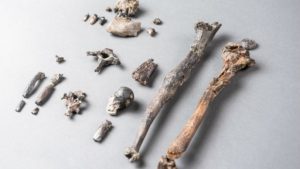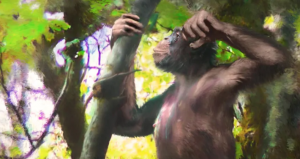The remains of an ancient ape found in a Bavarian clay pit suggest that humans’ ancestors began standing upright millions of years earlier than previously thought, scientists said Wednesday.
An international team of researchers says the fossilized partial skeleton of a male ape that lived almost 12 million years ago in the humid forests of what is now southern Germany bears a striking resemblance to modern human bones. In a paper published by the journal Nature, they concluded that the previously unknown species — named Danuvius guggenmosi — could walk on two legs but also climb like an ape.

The findings “raise fundamental questions about our previous understanding of the evolution of the great apes and humans,” said Madelaine Boehme, of the University of Tübingen, Germany, who led the research.
The question of when apes evolved bipedal motion has fascinated scientists since Charles Darwin first argued that they were the ancestors of humans. Previous fossil records of apes with an upright gait — found in Crete and Kenya — dated only as far back as six million years ago.
more at cba.ca
Ask me anything
Explore related questions





